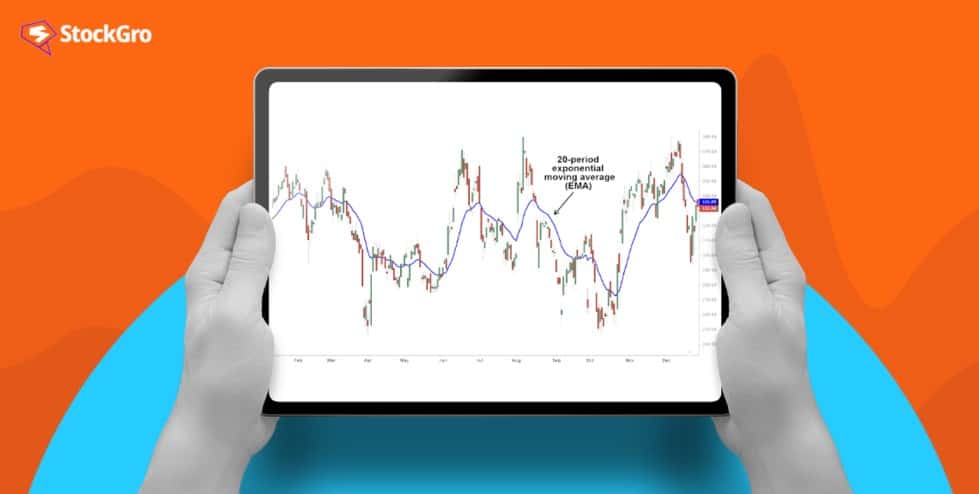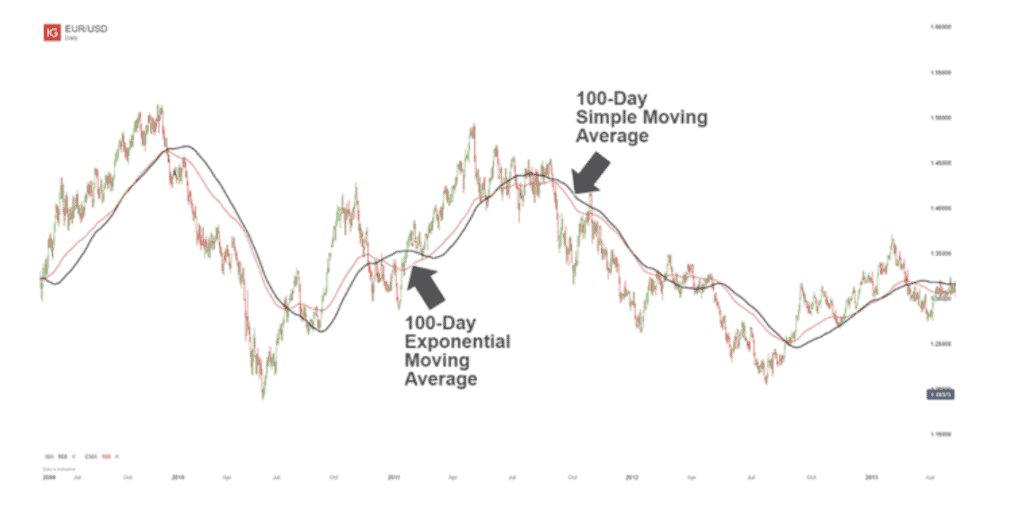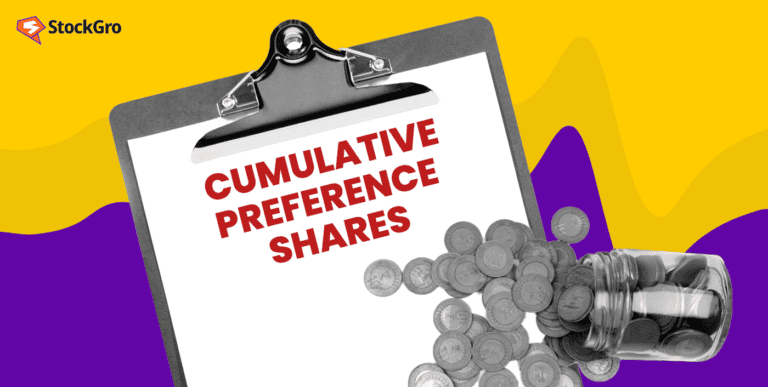
Just like any other technical indicator, the EMA exists to give traders an edge over others like them in the market. In the ever-volatile and dynamic world of stock market trading, there’s no such thing called too much information – and the EMA is a testament to that sentiment.
The EMA is not a static indicator – which means it’s not one that analyses data on a case-to-case basis. It is a continuous indicator, which means that it’s constantly working to analyse the change in an asset’s price. It never stops doing what it does – which is calculating an evolution of moving averages.
In this article, we’re going to explore what the EMA is, what its underlying principles are, the rationale behind its importance, and its role in the toolkit of numerous traders around the world.
You may also like: Do all technical analysis tools work equally well?
What is the EMA?
EMA is short for Exponential Moving Average. The EMA is one of several other moving averages, which are used to check the average price movement of a security over time. Moving averages use the closing prices of the asset over specific periods to perform these calculations.
Moving averages like the EMA can be used to determine broader market trends. The larger the time frame they consider, the broader is their analysis over time. Generally, there are three main types of moving averages:
- Simple moving average (SMA)
- Exponential moving average (EMA)
- Weighted moving average (WMA)
The EMA gives more weightage to more recent data points – which means that recent price movements have a greater effect on the EMA than on other averages. When compared to an SMA (which applies an equal weight to all observations), the EMA tends to adjust course a lot with recent volatility.
Note: The EMA and the SMA are both indicators that chart historical price movements. They do not predict future movements per se. Traders use the patterns they make over time to understand how a particular stock’s price regularly moves and make calculated bets based on that information.
Also read: What is ADX indicator? Make informed trades by tracking market trends
Calculating the EMA manually
Although every decent charting and trading software has an option for EMA now, here’s a step-by-step on how to calculate the EMA manually. This will help you understand the mechanics behind the indicator:
- Choose a time frame: The first step in calculating the EMA is to determine the time period for which you want to calculate the average. Typically represented by n”, this frame can be customised based on your strategy. For instance, you might use a 10-day EMA for short-term trading or a 50-day EMA for longer-term investing.
- Start with the SMA: To begin calculating the EMA, you first calculate the SMA for the specified time period. The SMA is the arithmetic mean of the closing prices over that period. You sum up the closing prices for the specified number of days (chosen in Step 1) and divide by the number of days.
Hence, the SMA = Sum of Closing Prices / Number of Days - Calculating the EMA: Like we noted before, the EMA differs from the SMA in that the EMA gives more weightage to recent prices. The weighted multiplier for the EMA, hence, is calculated as follows:
Weighted Multiplier = 2 / (n + 1)
Following this, formulas for the EMA can be applied:
EMA = (Closing Price – Previous EMA) * Weighted Multiplier + Previous EMA - The “Closing Price” is the most recent price of the asset.
- The “Previous EMA” is the EMA calculated for the previous day (or the initial SMA on the first day of calculation).
The difference between EMA and SMA
Although the EMA and SMA are both moving averages used to calculate price action over time, there are some nuances to note for trading.
- The SMA is about calculating the average price data for a particular trading period. The EMA, on the other hand, focuses more on the current data.
- While a decent SMA can be derived in a relatively short-time period, it takes much more than 10 days worth of data to get an accurate 10-day EMA.

Also read: Discovering the secrets of the inverse head and shoulders pattern
Using the EMA in stock trading
There are some things you need to note before using the EMA in stock trading.
- The EMA is more sensitive to recent price movements compared to the SMA. Hence, current volatility in asset prices tend to impact the EMA’s trends more than the SMA’s.
- Short-term sensitivity means that the EMA can be used to predict short-term patterns and movements more reliably.
- The EMA determines the trend direction. Generally, when the EMA rises, it’s a bullish signal and vice versa.
- The EMA could, in certain circumstances, be used like a support for a rising price action.
Usually, the EMA is used for a 10, 20, 100, or a 200-day average. The 12 and 25-day averages are used to calculate both the Moving Average Convergence Divergence (MACD) and PPO – Percentage Price Oscillator (PPO).
Experts, however, say that the EMA should be used carefully when trading. While EMA signals are oftentimes reliable and helpful, they can frequently be wrongly interpreted as well.
In principle, EMAs are lagging indicators – which either confirm or reject market movements. The EMA can often be reliably used to counteract the adverse effects of price lags since it’s more sensitive to recent price movements. For instance, it is a positive trading signal when the EMA indicates an upward trend in an already-bullish market.
Advantages of Exponential Moving Average (EMA)
The EMA offers several advantages for traders and investors, particularly in analysing and interpreting market trends. To begin with, EMA provides greater sensitivity to recent price changes compared to the SMA. This makes it more effective for capturing short-term trends and reacting to volatility.
For instance, in a fast-moving market, EMA quickly reflects price changes, helping traders in making timely decisions. Traders often use it to identify potential reversal points or continuation trends.
When combined with other indicators like RSI or MACD, it can enhance trading strategies by confirming trend directions or strength. Lastly, EMA is very versatile. As a trader, you can use it across various timeframes, making it suitable for both short-term traders and long-term investors. This adaptability makes the EMA an important aspect of technical analysis for identifying and responding to market conditions.
Limitations of the EMA
Experts are still debating whether more emphasis should be placed on current price changes or not. Many traders believe that new data (or data that’s more current) gives a better reflection of the current trends of the security rather than historical data. Others disagree. They believe that giving more weightage to current data leads to more false alarms.
Conclusion
In the end, the EMA – along with the SMA – is a very good indicator of the current price movement. The EMA, by taking into account current events more impactfully, gives traders a better understanding of short-term volatility in the market. However, just like any other technical indicator, the EMA should be used in conjunction with other signals and metrics to make a more accurate and informed decision.
FAQs
What are common timeframes for using the EMA?
Some common time frames of EMA are 10, 20, 50, and 200 days. Shorter time frames like 10 or 20 days are typically used for short-term trading, while longer ones like 50 or 200 days help identify long-term trends. Day traders can focus on even smaller periods to monitor immediate price movements.
How can the EMA help in identifying trends?
The EMA’s direction and its position relative to the price can indicate trends. An upward-sloping EMA below the price often tells us about bullish momentum and a downward-sloping EMA above the price indicates a bearish trend. Crossovers, where shorter EMAs intersect with longer ones, also serve as key trend indicators.
What are the advantages of using the EMA over the SMA?
EMA is different from SMA in terms of recent price data. It focuses more on recent price data and it is more responsive to current market conditions. This helps traders react very quickly to short-term price changes. The EMA proves to be especially beneficial in volatile markets where capturing real-time price movements is crucial.
How can the EMA be integrated into trading strategies?
The EMA can be used in trend-following strategies, support/resistance identification, and crossover methods. For instance, when a short-term EMA crosses above a long-term EMA (golden cross), it indicates a bullish trend. On the other hand, a short-term EMA crossing below a long-term EMA (death cross) tells us that the trend is bearish.

